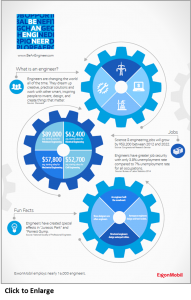Why Be An Engineer?
It’s interesting that I have been involved in STEM programs for the last twelve years and I have publicized, energized, and lately evangelized the importance of why we need, as a community, a city, a country, and even globally, to promote young people becoming excited about STEM and STEM careers. I was a product of involving girls in STEM in the 1960’s thanks to my father. He wasn’t an engineer but he supported my interest in science and moving things like trains, microscopes, and even that silly Mattel Creepy Crawler “Thing Maker.” “Girls don’t play with trains,” my mother told me when I was in high school as she attempted to reason with me to give my classic American Flyer train set away to my male cousin. “I never understood why your father gave you that train in the first place.”
She didn’t understand but at least I was able to keep putting the train up under the Christmas tree every year which kept her from secretly packing it up and giving it away as she did with many of my childhood toys and dolls. I was unaware that there was a career field called engineering and perhaps if I had known, I would have had an alternative in deciding to change majors in college. Engineering was an exclusive field that didn’t make it into the conversations or presentations in my high school. Perhaps the boys in the Physics class, an upper class elective, knew about engineering. The rest of us, however, were left aspiring to be doctors, lawyers, police officers, firemen, nurses, accountants, and other professions that we had been exposed to in elementary school and in our homes. I can’t remember ever hearing anyone talk about engineering in career day talks, college fairs, or in my high school counselor’s office. My mother worked for Delta Airlines. She wasn’t a mechanic, or an aeronautical engineer. She worked the public side of the airline industry. I never thought to ask her about the other side of the business and in her career day talks, I wonder if any students ever asked her about becoming a pilot, an airplane engine mechanic, or a designer of commercial aircraft.
Fast forward thirty years. In 1993, Congressman Louis Stokes of Cleveland, Ohio, concerned that minority students weren’t pursuing science and mathematics, worked with NASA’s Lewis Research Center and Cuyahoga Community College to create SEMAA (Science, Engineering, Mathematics, and Aerospace Academy). SEMMA was a STEM program at a time when nobody was calling science and mathematics STEM. The Internet was still a text based network with no images or color. Technology was computer science and Basic and Fortran were the programming languages being taught. Engineering, alas, was still not in the picture in most career awareness presentations. By the mid 2000’s, STEM started becoming the new buzz word. Unfortunately, as with all buzz words, many people and organizations, even many educational institutions, did not know how to properly implement STEM. I’ve judged science fairs that are now called STEM fairs where student projects had no engineering component in them anywhere. Now fast forward another twenty one years. As STEM has moved from an acronym that in 1993 was an obscure term used to encourage underrepresented and under-served populations to look at and become engaged in science and math in new, more engaging ways to stop that, “I hate math, I hate science,” mentality because “It’s hard,” into making STEM fun, exciting, interesting, imaginative, and purposeful. My question to everyone out there who has turned their science programming into STEM programming is, “Is it purposeful?” Are you working towards an end goal that will really inspire young people to WANT to go to college and major in a STEM career field and graduate then pursue a STEM career or are you just capitalizing on the acronym to gain funding, media attention, and student participation that costs parents and a year or two later those students are playing soccer, joining cheerleading and pom-pon squads, playing basketball, or involving themselves in other activities that are far removed from anything science, technology, mathematical, or technologically relevant. This is why, forty-five years after the United States landed on the Moon, we still have a huge shortage of qualified individuals in this country to fill the thousands of engineering jobs that are available.
Here is a blog post from Exon Mobile explaining why we need engineers. Let’s hope it doesn’t take us another forty-five years before we take the need to inspire and engage our youth to pursue engineering as a career.
Why Be An Engineer
America has a problem: Not enough U.S. students are pursuing engineering careers.

That troubling fact helps explain why there are currently millions of vacant jobs across our nation, even as the number of Americans not in the labor force is the highest it’s ever been.
There simply are not enough applicants with adequate skills to fill many of the most promising positions available in the 21st century. This lack of skills is especially acute in jobs that increasingly rely on science, technology, engineering, and math.
This set of circumstances is worrisome for science-based companies like ExxonMobil, of course. But more broadly it is troubling for America’s future competitiveness in the global economy.
To help address this predicament, ExxonMobil has launched a nationwide initiative seeking to inspire the next generation of engineers. Our Be an Engineer campaign aims to highlight the meaningful contributions that engineers make to the world, as well as provide resources to assist young people interested in pursuing the profession.
In the weeks and months ahead we’ll be running a number of commercials on television in support of this effort. You can catch them at ExxonMobil’s YouTube channel as well.
Over the next few weeks I will occasionally turn this space over to guest bloggers who will share their experiences as engineers and why engineering can make for a rewarding and valuable career. Among them is Dan Mote, longtime educator and currently the president of the National Academy of Engineering.
Today, though, I want to share with you a few thoughts on the state of engineering in America offered by our Chairman and CEO, Rex Tillerson.
Rex is an engineer himself, with a degree in civil engineering from the University of Texas. These remarks, culled from various interviews and speeches he has given the last few years, are instructive for why we are pushing ahead with our Be an Engineer initiative:
We’ve got to help young people understand how exciting the world of the engineer is to be able to create things that have never been created before. …
One of the challenges we’ve had as a profession is that young people don’t really know what an engineer does. And it can take on a certain connotation of being nothing more than a technician, when in reality scientists discover things and help us understand why they are. Mathematicians help us calculate and measure. …
Engineers are the marriage of science and mathematics. We take those two things, we put them together and we create everything around us, from your iPad to this building we’re sitting in to the medium that we’re broadcasting to people today to the houses we live in to the cars we drive. They are all engineering products.
I am confident that the more that young people actually learn what engineers do and accomplish for society, the more they will be drawn to pursuing careers in that direction.
Solar Eclipse
If you are in the Wisconsin area on Thursday, October 23, 2014 please come by Yerkes Observatory in Williams Bay Wisconsin to view the partial Solar Eclipse. Yerkes is a Legacy Partner of my STEM outreach program and I can guarantee the experience will be well worth the trip!
Yerkes Observatory Solar Eclipse Event
Yerkes Observatory in Williams Bay, Wisconsin is offering a special opportunity for people to safely watch a partial solar eclipse: an astronomical event where the moon passes between the earth and the sun, appearing to block out part of the sun. This phenomenon is relatively rare to see.
The program will run from 4:00–6:00 pm on Thursday, October 23rd (the eclipse itself begins just after 4:30 pm). Various solar viewing instruments will be available for safely watching the eclipse. Some eclipse related activities will also be provided. We encourage people to arrive promptly at four, but that is not required; we will be open throughout the event. The event will occur regardless of weather.
The cost for this event is $5 per person, or maximum of $15 per family. Pre-registration is appreciated. Children must be accompanied by adults. No pets, please.
To register or for more information, please visit http://astro.uchicago.edu/yerkes/, and follow the link on the home page.
Throughout the year Yerkes is open for free public tours on Saturday mornings, as well as offering special group tours and various programs. Other events at Yerkes are also posted on the website given above.



